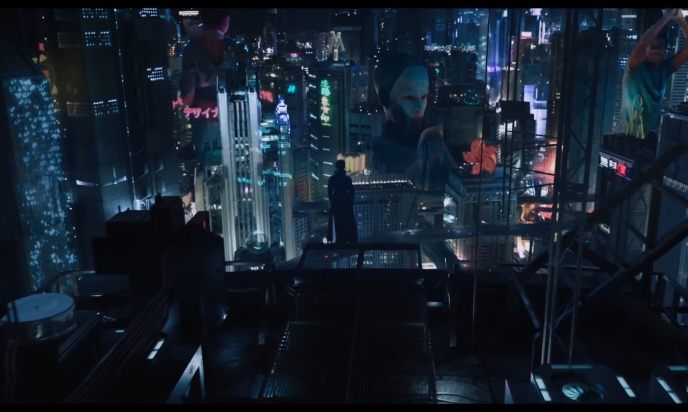Rating: ★★★ out of 5
In Ghost in the Shell, technology has advanced to the point that humans can replace their own body parts with cybernetic versions. They can even have their mind, or “ghost,” implanted into a completely artificial body. The film centers on a woman, often referred to simply as “Major,” who is a member of a covert counter-terrorism unit and purpotedly the first human mind to be implanted into a fully cybernetic body. As she adapts to her new body, Major struggles to find a sense of self and identity. Is she human? Is she a robot? Are her memories her own, or a complete fabrication? These questions haunt Major as she assists the company that created her body, Hanka Robotics, in hunting down a killer who is going after members of the Hanka research team.

Visually, Ghost in the Shell creates a beautifully futuristic version of Tokyo. It benefits greatly from its source material, and in some ways is even reminiscent of Enter the Void’s psychadelic color scheme and neon cityscape, while the virtual ads the size of skyscrapers and underworld of body modifcation recall the dystopian world from Repo! The Genetic Opera. The plot is engaging, and while it does diverge at times from the 1995 anime version, it is still a close enough representation to please most fans of the Ghost in the Shell brand. It deals directly with many of the same themes from the original, namely addressing questions of identity and definitions of humanity in a world where the lines between human and computer begin to blur, though it rarely gives them much more than a glance, instead focusing more on action and flashy CGI.

Despite its beautiful visuals, entertaining story, and interesting philosophical quandries, Ghost in the Shell is far from perfect. The principal drawback of this otherwise entertaining film is the casting. Scarlett Johansson, along with a plethora of American and European actors and actresses, star in what should be a distinctly Japanese story. The film is set in a futuristic version of Tokyo, many of the characters have Japanese names, and the main character, Major, is part Japanese, part cybernetic body. While there are a few Japanese actors in ancillary roles, they seem to be thrown in as an afterthought more than an actual attempt to embrace the uniquely Japanese story. Outside of the characters and the city, Ghost in the Shell makes a few references to its Japanese origins (primarily through Major’s visions of traditional Japanese temples from her childhood and the inclusion of cybernetic robots made to look like Geishas), but they often feel forced and disingenuous.
Of course, this is not the first film to be “white-washed” by Hollywood, and certainly it will not be the last. The excuse here, as it has always been, is that big-name (generally white) actors pull in larger audiences than lesser known foreign or minority actors. However, one of the key elements of what usually makes a good film is that, during the actual viewing, audiences are drawn so deeply into the story that they forget they are watching a movie. But to cast Scarlett Johansson in a role that was clearly made for a Japanese actress (of which there are many who are far more talented than Johansson), and then to tell audiences that her character is (at least in part) Japanese, completely takes viewers out of the film. So yes, Ghost in the Shell may have made the financeers happy, but the filmmakers undercut and devalued an otherwise well-made adaptation with poor casting decisions.
